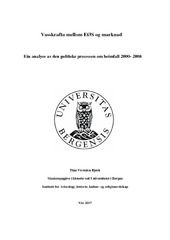| dc.contributor.author | Bjørk, Tina Veronica | |
| dc.date.accessioned | 2017-09-06T06:53:55Z | |
| dc.date.available | 2017-09-06T06:53:55Z | |
| dc.date.issued | 2017-06-17 | |
| dc.date.submitted | 2017-06-16T22:00:14Z | |
| dc.identifier.uri | https://hdl.handle.net/1956/16575 | |
| dc.description.abstract | This Master's dissertation examines the development of the conditions for concession for acquisition of hydropower resources between 2000 and 2008. During this period the Norwegian hydropower resources came under pressure. The goal of this study is to understand the mechanism of the whole political process. The method used here is qualitative, based on document analysis and an interview. There has been a broad political concensus on the public ownership of hydropower resources. The tradition in favour of a strong public ownership can be traced back to the beginning of the 20th century. The legal right to concession for acquisition of hydropower resources introduced in 1909, was linked to the public sector. While public owners recieved perpetual concessions, private ones were limited. After the end of the concession period, waterfalls and power plants went to the state without compensation. The concession for acquisition scheme meant that most of the hydropower was in public ownership. In spite of minor modifications this scheme remained unchanged for almost hundred years. Both the deregulation of the energy market in the 1990s and the EEA agreement in 1992 were determining factors in the EFTA Surveillance Authority(ESA) setting a limit for the Norwegian scheme on concession to hydropower resources in 2000. In their view, the private hydropower owners were discriminated against in favour of the public counterparts. To be more precise, it referred to this state of affairs as a break against the principle of free enterprise and free movement of capital as established in the EEA law. Two different governments with unlike points of view on the acquisition and concession issue handled the case between 2000 and 2008. Norway and the ESA could not reach an agreement and the case came before the EFTA court in 2007. Norway lost and had to change the rights to concession for acquisition of hydropower resources. In 2008 this case came to and end when the Norwegian government agreed to exploit the premises in the court decision. Public ownership of hydropower resources was strengthened. The development of the case for conditions for concession and acquisition of hydropower resources was marked by two parallel and continuous lines. These were the Norwegian energy policy and the relationship between Norway and the EU. Hydropower has been described as Norway's heritage. This metaphor says something about how significant hydropower has been in society over several generations. | en_US |
| dc.language.iso | nno | eng |
| dc.publisher | The University of Bergen | eng |
| dc.title | Vasskrafta mellom EØS og marknad Ein analyse av den politiske prosessen om heimfall 2000- 2008 | eng |
| dc.title.alternative | Hydropower resources between the EEA and energy market | eng |
| dc.type | Master thesis | |
| dc.date.updated | 2017-06-16T22:00:14Z | |
| dc.rights.holder | Copyright the author. All rights reserved | eng |
| dc.description.degree | Historie mastergradsoppgåve | |
| dc.description.localcode | MAHF-HIS | |
| dc.description.localcode | HIS350 | |
| dc.subject.nus | 713107 | eng |
| fs.subjectcode | HIS350 | |
| fs.unitcode | 11-22-00 | |
